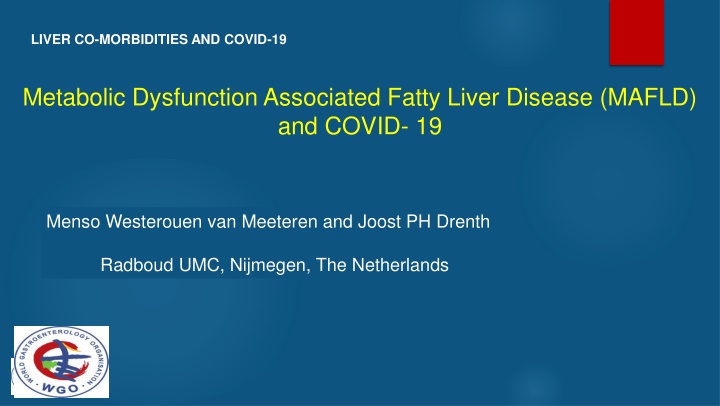
Metabolic Dysfunction Associated with Fatty Liver Disease and COVID-19
Explore the association between Metabolic Dysfunction Associated Fatty Liver Disease (MAFLD) and COVID-19, including the risk of SARS-CoV-2 transmission, the role of ACE-2 receptors in liver health, potential therapeutic targets in MAFLD and liver fibrosis, as well as the impact of MAFLD on COVID-19 severity and prognosis. Understand the metabolic risk factors contributing to a severe course of COVID-19 and the implications of MAFLD on respiratory disease progression and liver biochemistry abnormalities.
Download Presentation

Please find below an Image/Link to download the presentation.
The content on the website is provided AS IS for your information and personal use only. It may not be sold, licensed, or shared on other websites without obtaining consent from the author. If you encounter any issues during the download, it is possible that the publisher has removed the file from their server.
You are allowed to download the files provided on this website for personal or commercial use, subject to the condition that they are used lawfully. All files are the property of their respective owners.
The content on the website is provided AS IS for your information and personal use only. It may not be sold, licensed, or shared on other websites without obtaining consent from the author.
E N D
Presentation Transcript
LIVER CO-MORBIDITIES AND COVID-19 Metabolic Dysfunction Associated Fatty Liver Disease (MAFLD) and COVID- 19 Menso Westerouen van Meeteren and Joost PH Drenth Radboud UMC, Nijmegen, The Netherlands
Content MAFLD and risk of SARS-CoV-2 transmission MAFLD and COVID-19 prognosis.
Risk of acquiring SARS-CoV-2 infection Unknown if MAFLD increases risk of acquiring SARS-CoV-2 infection. ACE-2 receptor speculated as potential cause for increased transmission. ACE-II expression low in healthy liver Chronic liver injury increases ACE-2 expression in: Liver fibrosis mice models Human hepatitis C Cirrhosis explants (Paizis, Tikellis et al. 2005)
ACE-2 role in MAFLD Ang 1-7 activator reduces steatosis and inflammatory markers in mice ACE-2 activator decreases lipogenesis ACE-2 knock-out mice develop Insulin resistance Spontaneous liver fibrosis Feltenberger, Andrade et al. 2013 de Macedo, Guimarares et al. 2015) Osterreicher, Taura et al. 2009
RAS modulation in MAFLD & Liver injury RAS modulation potential therapeutic drug target in MAFLD and liver fibrosis (Ahmadian, Pennefather et al. 2016)
Metabolic risk factors & severe COVID-19 course Systematic review and meta-analysis, 20 articles (4062 COVID-19 patients) Diabetes, hypertension and CVD increased likelihood of severe disease (Xu, Mao et al. 2020)
MAFLD & COVID-19 severity Cohort study of 202 COVID-19 patients (MAFLD, n=76) Patients with MAFLD had: Higher risk of respiratory disease progression (44.7 vs. 6.6%) Higher likelihood of abnormal liver biochemistry (70% vs. 11.1%) (Xu, Mao et al. 2020)
MAFLD & COVID-19 severity Cohort study of N= 202 COVID-19 patients (MAFLD, n=76) Patients with MAFLD had: higher risk of respiratory disease progression (44.7 vs. 6.6%) higher likelihood of abnormal liver biochemistry (70% vs. 11.1%) (Xu, Mao et al. 2020)
Obesity in MAFLD patients & COVID-19 severity Chinese cohort study selected N=66 MAFLD patients Obesity (BMI > 25 kg/m2) (n=45) Increased the risk of severe COVID-19 Significant after adjustment for other risk factors (Zheng, Gao et al. 2020)
MAFLD and community acquired pneumonia (CAP) Nested case control study N=561 hospitalized CAP patients 30-day mortality from pneumonia: 17% in MAFLD patients 5.8% in non-MAFLD patients (Nseir, Mograbi et al. 2019)
Conclusions Unknown if MAFLD increases risk of SARS-CoV-2 transmission MAFLD and associated metabolic risk factors increase likelihood of severe course of COVID-19 disease.
